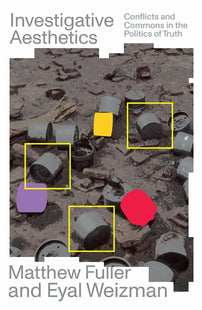Investigative Aesthetics: a Letter from the Editor
"Matthew Fuller and Eyal Weizman are thinkers at the forefront of this aesthetic revolution, and this book opens up and theorizes a new field that is already transforming the way we think about art practise as well as the wider context of sensing the world." - Leo Hollis, editor

Investigative Aesthetics by Matthew Fuller and Eyal Weizman is now available for preorder and is an August selection in the Verso Book Club.
Imagine a crime scene. Forensics are on the ground. The police tape has been wrapped the areas cordoning off the place of violence. The public have been pushed back by the authorities so they can get on with their work. Surely, this is a moment for professional investigators. The designated detective scopes the landscape, the forensic officer searches for fragments of evidence, later the judge, representing the state, will conduct the case in court. But what of the role of architect? The artist? The hacker? Do they have a place within this investigation, especially when the crime has been committed by the state, which gives the detective, the forensic officer and the judge their authority?
There is something changing in our galleries and museums. Spaces that were once given over to the pursuit of beauty and arts have become laboratories of investigation. At the same time, as technologies of sensing, and sense making, have become increasingly prevalent, the tools of the detective and the forensic officer have become available to everyone who wishes to expose the truth of state violence and inequality. The white cube has become a place of counter forensics, the museum a courtroom.
Matthew Fuller and Eyal Weizman are thinkers at the forefront of this aesthetic revolution, and this book opens up and theorizes a new field that is already transforming the way we think about art practise as well as the wider context of sensing the world. The two authors work together at Goldsmiths, Fuller is Professor of Culture Studies, while Weizman runs Forensic Architecture, the research group that uses multidisciplinary methods of architectural technologies to investigate crimes.
Together they try to rethink the ways technologies have changed the way we see the world. From surveillance to information overload, wikileaks to the smart city, the relationship between sensing and making sense demands a new approach, a new system of aesthetics: that takes ecologies, politics and science into account alongside speculative and critical theory. And it is in the work of groups like Forensic Architecture as well as others, where we see this playing out.
Such work finds a home in the International Criminal Court as well as the Tate Modern or the Whitney Biennial. It also has a place on the front pages of the newspapers, such as the work of Bellingcat, which seeks citizens to help in open source investigations. All of these new methods force us to rethink the role of art, but also to find new ways to confront power.
- Leo Hollis, editor
